Lecithin And Phospholipids Market Research, 2031
The global Lecithin and Phospholipids Market Size was at $5.1 billion in 2021, and is projected to reach $8.8 billion by 2031, growing at a CAGR of 5.6% from 2022 to 2031.
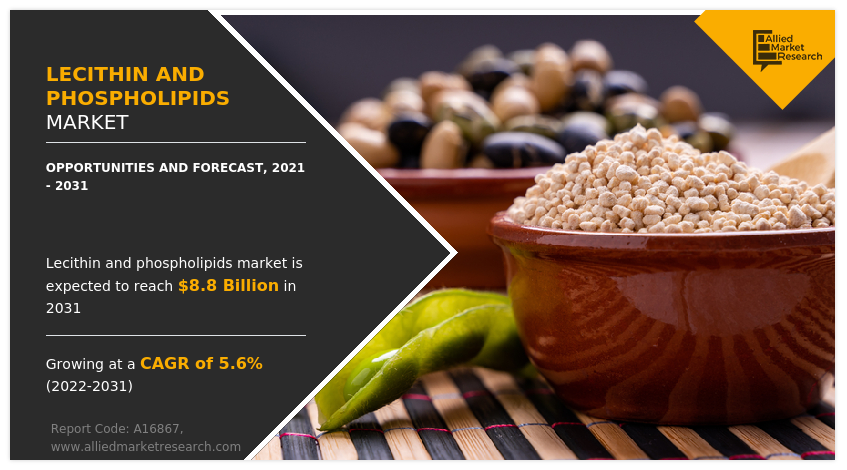
Market Dynamics
Lecithin is a naturally occurring nutrients that can be found in read meat, eggs, and green leafy vegetables. Lecithin when sold as a dietary supplement its derived from animal products, soybean, and egg yolks. These dietary supplements used to reduce cholesterol levels. Apart from that, it can also help to benefit some medical conditions such as neurological and inflammatory conditions.
Lecithin is a group of chemicals that belongs to phospholipids compounds. Phospholipids are one of the major types of fat that supports the integrity of cells. They are important fats to have a normal function of liver, brain, nerves, and other organs. Lecithin is used in food industry as an emulsifier. This emulsifier helps to stabilize ingredients which cannot be easily mixed, for instance, oil and water. Apart from food industry it is also used in personal care and healthcare industry.
The rising population and the increasing demand for food products have made the food security term an important factor. According to United Nations, by 2030 the global population is expected to reach over 8.6 billion. Roughly, on a yearly basis 83 million people being added to the world’s population and this upward trend is projected to continue. It is currently unmanageable to boost food production to a level that can satisfy the demands of the constantly expanding human population while limiting the availability of new agricultural land. Currently, 30% of the world's land area is used for agriculture. However, to fulfil this ever-increasing demand the manufacturers of food products are focusing on increasing the shelf life of the product.
Moreover, according to United Nations Food and Agriculture Organization (FAO), 75% of the total food produced for consumption of human is being wasted. The wastage of food is not economical and shows very low sustainability. The use of food additives such as emulsifiers will assist in reducing the wastage. Food additives can help to solve the problem of limited natural ingredient supply, extended shelf life, and simplify complex cooking operations.
The increasing availability of processed and ready-to-eat food such as dairy products, meals, meat products, pasta, among others have focused consumers shift towards them. The overall time and efforts for the preparation of meals have reduced owing to the availability of ready-to-eat and processed products. The food & beverage industry is continuously evolving and is taking care of the changing food habits of consumers. Presently, consumers are demanding the highest quality food & beverage goods at affordable prices. Pre-cooked or ready meals are less time-consuming, cost-effective, and easy to prepare. These advantages have fostered the demand for quick meals, especially among working population and students. Lecithin and phospholipids are being used as an emulsifier during the preparation of food & beverages, as they improve the product quality, enhance texture, and function as a food thickener. As a result, increase in packaged food sales is supporting the expansion of the lecithin and phospholipids market.
Moreover, lecithin and phospholipids are used during the manufacturing of animal feed. The chemical and unique physical properties of lecithin have attracted animal feed manufacturers. Lecithin improves quality of animal feed and also improves the fertility rate in livestock especially fish and shrimp. The appropriate use of lecithin and phospholipids in animal feed can help in improving the lactation of mammals, hatching rate of poultry eggs, hatching rate of fish and crab eggs, and the breeding rate of seedlings.
The manufacturing of lecithin and phospholipids is a complex process that must comply with the regulations established by many governments. Lecithin and phospholipids and food additives are thoroughly tested by scientific expert groups at national and international levels. Authorities such as the European Food Safety Authority (EFSA), and state authorities, and the Joint FAO/WHO Expert Committee on Food Additives (JECFA) are responsible for the approval of the ingredients during the manufacturing of food products. EFSA is responsible for inspection and approval of lecithin and phospholipids during each stage of the production process and has set guidelines to fulfill the requirements to be used in food and beverage products in Europe. Furthermore, FDA has guidelines for lecithin and phospholipids that are appropriate for usage within their respective restrictions in North America. However, enforcement of stringent government regulations on the use of lecithin and phospholipids has declined the development pace of the lecithin and phospholipids market.
Segmental Overview
In lecithin and phospholipids market, we have considered the source, type, application, and nature as a scope of study. Source includes the analysis of soy, sunflower, rapeseed & canola, egg, and other. Based on type the market is classified as fluid lecithin, de-oiled lecithin, and modified. Based on application, the market is bifurcated into feed, food & beverages, industrial, and healthcare. The food & beverage segment has been further bifurcated into confectioneries, convenience foods, bakery products, and others. Based on region the lecithin and phospholipids market is categorized into North America, Europe, Asia-Pacific and LAMEA.
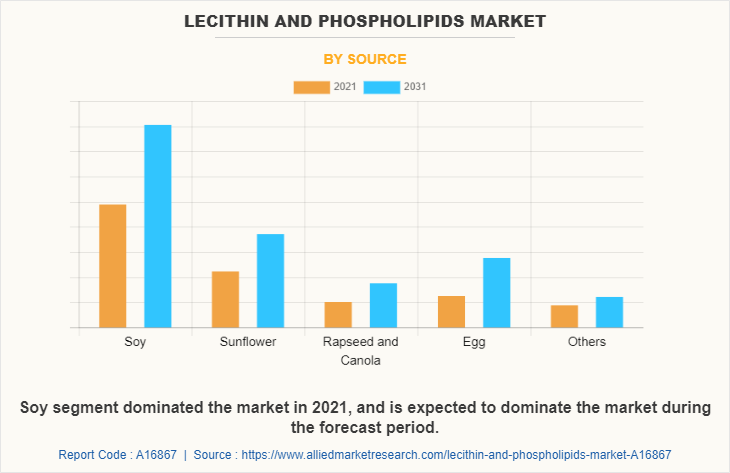
On the basis of source, soy segment garners the largest Lecithin and Phospholipids Market Share in 2021. However, egg segment is projected to grow at the fastest CAGR during the projected period. Soy lecithin is a phospholipid extracted from soybeans and added to foods or supplements. Lecithin manufactured through conventional soybeans are processed using acetone, hexane, and other chemical solvents. Lecithin derived through soy source can be found in whey protein, pre-workout formulas, and other sports supplements. Apart from that it is also used in bakery products, chocolates, and cereals. The increasing demand for these food products is likely to drive the demand for soy lecithin during the Lecithin and Phospholipids Market Forecast period. However, allergic reactions associated with the consumption of soy will restrict the Lecithin and Phospholipids Market Growth.
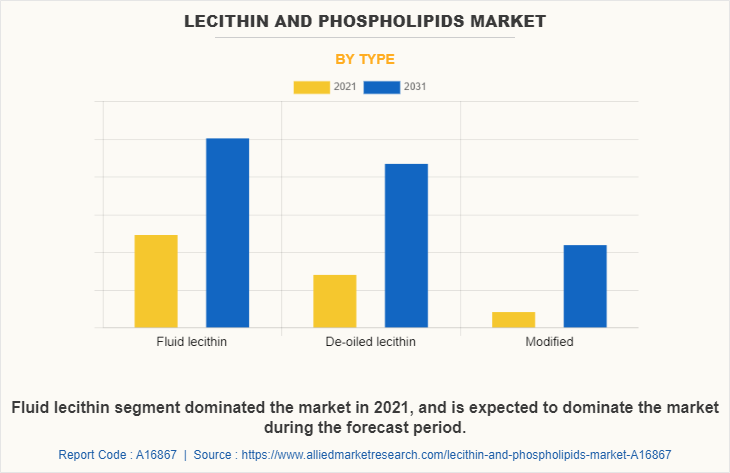
On the basis of type the lecithin and phospholipids market is classified as fluid lecithin, de-oiled lecithin, and modified. The fluid lecithin segment dominated the lecithin and phospholipids market in 2021 with a market share of more than 43.5% for the same year. The growth is attributed to the high demand for fluid lecithin from application industries. Fluid lecithin products are standardised fluid blends of natural phospholipids and vegetable oils that are stable and easy to handle. Fluid lecithin possess amphiphilic properties due to its active molecules. Meaning, one end of molecule behaves lipophilically i.e. oil-friendly while other has hydrophilic properties. The presence of the above-mentioned properties gives lecithin emulsifying properties. Thus, it can be used in bakery, confectionary, and other food & beverage products.
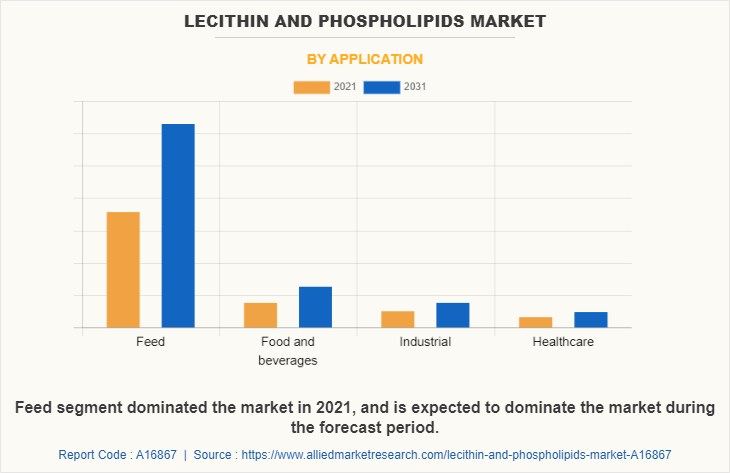
On the basis of application, the lecithin and phospholipids market share is bifurcated into feed, food & beverages, industrial, and healthcare. Feed segment dominated the global market in 2021. Meat production and consumption has increased rapidly over the years due to increased disposable income of the consumers and the health benefits offered by meat. In addition, meat is a rich source of proteins, important vitamins, and various other nutrients such as iron, zinc, B12, and B6. It has been observed that meat consumption in the developing economies is higher than the developed regions. The economic growth, changes in lifestyle, population growth, and other structural changes are driving the livestock revolution, and hence supplementing the overall growth of the animal feed additives market. This factor will also propel the Lecithin and Phospholipids Market Demand in animal feed.
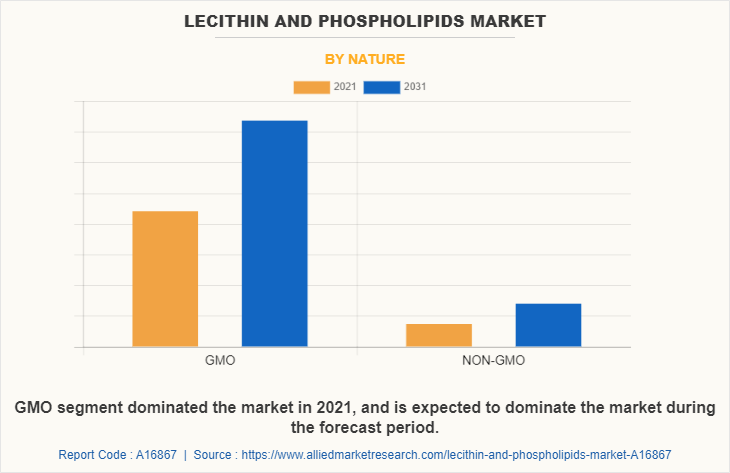
On the basis of nature, the lecithin and phospholipids market size is bifurcated into GMO and non-GMO. A genetically Modified Organism (GMO) is an animal, plant, or microbe whose DNA has been altered using genetic engineering techniques. Agricultural products and animals have been selectively bred over generations to have certain desired traits. Using biotechnology, scientists have been able to avoid this problem and improve the genetic modifications of an organism without unwanted characteristics tagging along. Thus, the high availability of GMO products through which lecithin and phospholipids have increased the segmental demand.
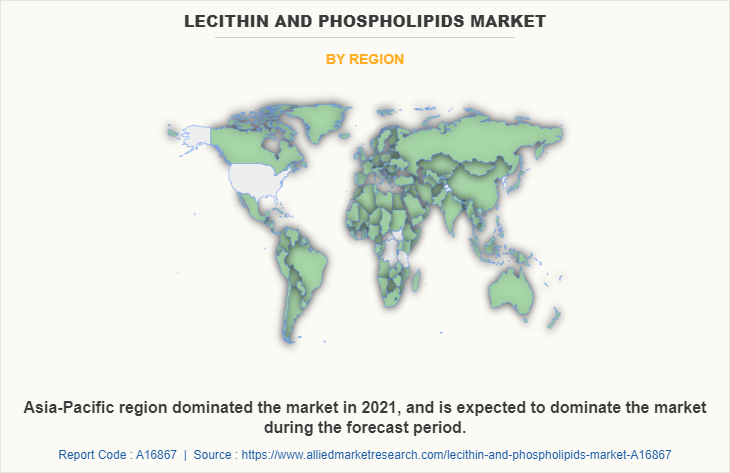
Region-wise, Asia-Pacific was the highest revenue contributor and is estimated to reach $3,148.8 million by 2031, with the highest CAGR of 6.3%. LAMEA is likely to grow at a moderate pace during the estimated period. This is due to the industrialization of meat production and the increase in meat consumption in the region. Also, a rise in disposable income in economies such as India and China is expected to register fast-paced growth in the area. Furthermore, subsidies on meat exports in countries such as India are encouraging manufacturers to increase meat production, thereby boosting the development of the animal feed additives market. In addition, growth in the culture of intensive farming systems, along with an increase in number of local feed manufacturers in this region are expected to drive the Asia-Pacific market in the future. Apart from that, investment opportunities and favourable government policies to set up lecithin and phospholipids production facility will likely to create an opportunity for market players operating in lecithin and phospholipids market.
Competition Analysis
The key players operated in the global Lecithin and Phospholipids industry includes Cargill, ADM, DuPont, MCD Group BV., Bunge Limited, Stern-Wywiol Gruppe, Wilmar International Ltd., Sonic Biochem, Avril Group, American Lecithin Company, Vav Life Sciences Pvt Ltd., Sondrugestvo Group, Kewpie Corporation, Fismer Lecithin, and Lipoid GmbH.
Key Benefits For Stakeholders
- This report provides a quantitative analysis of the market segments, current trends, estimations, and dynamics of the lecithin and phospholipids market analysis from 2021 to 2031 to identify the prevailing lecithin and phospholipids market opportunities.
- The market research is offered along with information related to key drivers, restraints, and opportunities.
- Porter's five forces analysis highlights the potency of buyers and suppliers to enable stakeholders make profit-oriented business decisions and strengthen their supplier-buyer network.
- In-depth analysis of the lecithin and phospholipids market segmentation assists to determine the prevailing market opportunities.
- Major countries in each region are mapped according to their revenue contribution to the global market.
- Market player positioning facilitates benchmarking and provides a clear understanding of the present position of the market players.
- The report includes the analysis of the regional as well as global lecithin and phospholipids market trends, key players, market segments, application areas, and market growth strategies.
Lecithin and Phospholipids Market Report Highlights
| Aspects | Details |
| Market Size By 2031 | USD 8.8 billion |
| Growth Rate | CAGR of 5.6% |
| Forecast period | 2021 - 2031 |
| Report Pages | 335 |
| By Source |
|
| By Type |
|
| By Application |
|
| By Nature |
|
| By Region |
|
| Key Market Players | Bunge Limited, LIPOID GMBH, Fismer Lecithin, DuPont de Nemours, Inc., Croda International Plc, Avril Group, Archer-Daniels Midland Company, Cargill, Incorporated, Sonic Biochem Extractions Limited, American Lecithin Company, IMCD Company, Kewpie Corporation, Stern-Wywiol Gruppe Gmbh Co. Kg, Wilmar International Ltd, VAV Life Sciences Pvt. Ltd. |
Analyst Review
The demand for lecithin and phospholipids among animal feed manufacturers is on the rise; industry participants are focusing on product development and introduction of clean label ingredient in the market. Lecithin is a group of phospholipids can be found in plant and animal tissues. It is an important substance for proper biological functioning of body. Phosphatidylcholine (PC), main component in lecithin is responsible for health benefits offered by lecithin. Lecithin is majorly produced through soy. Hence, people with allergies associated with consumption of soy should check the source of lecithin in food & supplements before consuming. In the U.S., many large-scale commercial crops are produced through GMO source which includes soybean plant. This ensures the growth of market owing to the high availability of GMO plants. Lecithin and phospholipids are used in swine feed, poultry feed, aquaculture feed, and ruminant feed. Lecithin has a significant improvement on the growth rate of the weaned piglets and the digestion and absorption rate of fat. The need to produce sows has increased with the increase in demand for pig meat. Adding lecithin to the sow feed increase the milk yield and also improve the milk quality (milk fat percentage). The addition of 1-2% lecithin to sow feed has an important impact on the healthy development of piglets. North America witnessed growth in the consumption of meat as a source of protein, which resulted in increased demand for meat. In addition, an increase in livestock production, and technological innovations boost the demand for animal feed additives in the region. This ensures the market growth for lecithin and phospholipids as well. Furthermore, the shortage of water in the region has resulted in intense use of animal husbandry for crop production. Also, alarming necessity to improve food security, and growth in preference for processed food fuel the sale of lecithin and phospholipids. Therefore, all these factors are increasing awareness about the benefits of lecithin and phospholipids among consumers and are estimated to drive the growth of the lecithin and phospholipids market during the forecast period.
The global Lecithin and Phospholipids Market Size was at $5.1 billion in 2021, and is projected to reach $8.8 billion by 2031
The global Lecithin and Phospholipids market is projected to grow at a compound annual growth rate of 5.6% from 2022 to 2031 $8.8 billion by 2031
The key players operated in the global Lecithin and Phospholipids industry includes Cargill, ADM, DuPont, MCD Group BV., Bunge Limited, Stern-Wywiol Gruppe, Wilmar International Ltd., Sonic Biochem, Avril Group, American Lecithin Company, Vav Life Sciences Pvt Ltd., Sondrugestvo Group, Kewpie Corporation, Fismer Lecithin, and Lipoid GmbH.
Region-wise, Asia-Pacific was the highest revenue contributor
The increasing availability of processed and ready-to-eat food such as dairy products, meals, meat products, pasta, among others
Loading Table Of Content...



